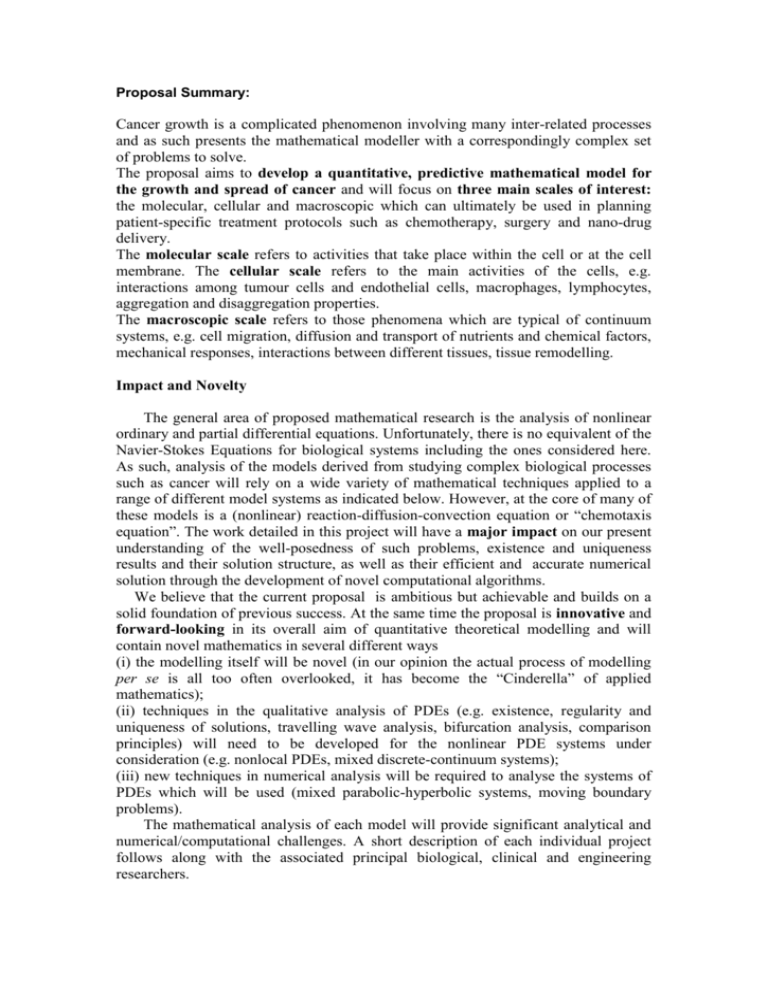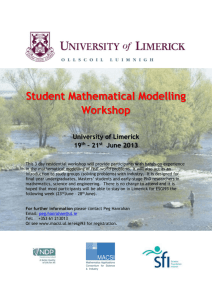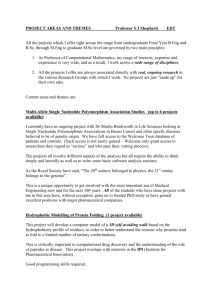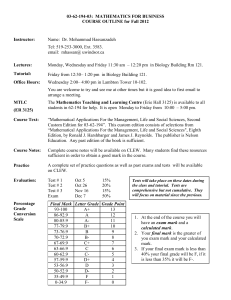Proposal Summary:
advertisement

Proposal Summary: Cancer growth is a complicated phenomenon involving many inter-related processes and as such presents the mathematical modeller with a correspondingly complex set of problems to solve. The proposal aims to develop a quantitative, predictive mathematical model for the growth and spread of cancer and will focus on three main scales of interest: the molecular, cellular and macroscopic which can ultimately be used in planning patient-specific treatment protocols such as chemotherapy, surgery and nano-drug delivery. The molecular scale refers to activities that take place within the cell or at the cell membrane. The cellular scale refers to the main activities of the cells, e.g. interactions among tumour cells and endothelial cells, macrophages, lymphocytes, aggregation and disaggregation properties. The macroscopic scale refers to those phenomena which are typical of continuum systems, e.g. cell migration, diffusion and transport of nutrients and chemical factors, mechanical responses, interactions between different tissues, tissue remodelling. Impact and Novelty The general area of proposed mathematical research is the analysis of nonlinear ordinary and partial differential equations. Unfortunately, there is no equivalent of the Navier-Stokes Equations for biological systems including the ones considered here. As such, analysis of the models derived from studying complex biological processes such as cancer will rely on a wide variety of mathematical techniques applied to a range of different model systems as indicated below. However, at the core of many of these models is a (nonlinear) reaction-diffusion-convection equation or “chemotaxis equation”. The work detailed in this project will have a major impact on our present understanding of the well-posedness of such problems, existence and uniqueness results and their solution structure, as well as their efficient and accurate numerical solution through the development of novel computational algorithms. We believe that the current proposal is ambitious but achievable and builds on a solid foundation of previous success. At the same time the proposal is innovative and forward-looking in its overall aim of quantitative theoretical modelling and will contain novel mathematics in several different ways (i) the modelling itself will be novel (in our opinion the actual process of modelling per se is all too often overlooked, it has become the “Cinderella” of applied mathematics); (ii) techniques in the qualitative analysis of PDEs (e.g. existence, regularity and uniqueness of solutions, travelling wave analysis, bifurcation analysis, comparison principles) will need to be developed for the nonlinear PDE systems under consideration (e.g. nonlocal PDEs, mixed discrete-continuum systems); (iii) new techniques in numerical analysis will be required to analyse the systems of PDEs which will be used (mixed parabolic-hyperbolic systems, moving boundary problems). The mathematical analysis of each model will provide significant analytical and numerical/computational challenges. A short description of each individual project follows along with the associated principal biological, clinical and engineering researchers. Description of the Science/Assessment of its Innovation Cancer is characterized by multiple mutations in a single cell leading to a loss of control in cell replication accompanied by an uncontrolled growth of the total cell mass, eventually leading to the formation of an in-situ solid tumour. After the tumour reaches a certain size, genetic instability in the cancer cells may lead to further dedifferentiation within the malignant cell mass. The ability to invade tissue is one of the hallmarks of cancer. Cancer cells achieve this through the secretion of matrix degrading enzymes, cell proliferation, loss of cell-cell adhesion and active migration. A better understanding of the complex processes involved in cancer invasion will ultimately lead to treatments being developed which can localize cancer and prevent metastasis. The proposal is focused around three well-defined projects each dealing with a specific scale (spatial/temporal/both) andimportant biological systems which have important roles in cancer growth and development (i) intra-cellular signal transduction pathways; (ii) cancer cell migration, invasion of tissue and (iii) lymphangiogenesis and nano-drug delivery to solid tumours. The overall common theme of the project may be termed multi-scale mathematical modelling or, from a biological perspective, quantitative systems biology or quantitative integrative biology. A short description of each individual project follows Project I: Cell Cycle Project Aims: To develop and analyse mathematical models of key points of the cell cycle and key signal transduction pathways associated with cancer. The cell is the basic biological building block of life and the control, regulation and proper functioning of cells is of ultimate vital importance to the well-being of the individual where the cells are located. Any disruption of, or breakdown in, the processes which control cell division and migration play a crucial role in the development of cancer. Crucial processes which govern the regulation of cells are signal transduction pathways and the cell cycle. Signal transduction is the intracellular process by which cells co-ordinate their response to changes in the level of extracellular substances (e.g. growth factors, cytokines, nutrients). Abnormalities in these intra-cellular pathways (through incorrect phosphorylation of proteins) are a cause or consequence of major diseases and conditions such as cancer, heart attack, rheumatoid arthritis and diabetes. Modelling specific signal transduction pathways known to be important in cancer progression (and the cell cycle in general) will enable more effective nano-drugs to be developed that are specific inhibitors of kinases and phosphotases. The methodology used will be based on the description of the above processes by differential equations. Where appropriate, ordinary, partial, functional and stochastic differential equations will be utilized. Project II: Cancer cell invasion of tissue Project Aims: to develop predictive mathematical model of cancer cell invasion of tissue. The ability of cancer cells to break out of tissue compartments and invade locally gives solid tumours a defining deadly characteristic. The first step of invasion is the over-expression by the cancer cells of proteolytic enzymes, such as the urokinase-type plasminogen activator (uPA) and matrix metalloproteinases (MMPs). Degradation of the matrix then enables the cancer cells to migrate through the tissue and subsequently to spread to secondary sites in the body (metastasis). In this development of the modelling, we will incorporate a mathematical model of the urokinase plasminogen activation system. The model will consists of a system reaction-diffusion-taxis partial differential equations describing the interactions between the cancer cells, urokinase plasminogen activator (uPA), uPA inhibitors, plasmin and the host tissue. The spatio-temporal dynamics of the uPA system will be coupled to the cancer cells through chemotaxis and haptotaxis. Project III: Lymphangiogenesis, flow in lymph-vessel networks, and nano-drug delivery to solid tumours Project Aims: to develop a mathematical model of adaptive capillary lymphvessel growth; to examine non-Newtonian lymph-flow in these networks; to examine nano-drug delivery to tumours through the lymph-vessel networks. Lymphangiogenesis provide new lymphatic vessels that malignant cells can use to escape the confines of the primary tumor. Unlike the blood vascular network, the lymphatic network does not provide nutrients to cells. However, the lymphatic network is more conductive to tumor invasion and metastasis for several reasons. First, in comparison to blood vessels, lymphatic vessels have much larger cross section, thinner walls and poorly developed basement membrane. Additionally, lymphatic vessels endothelium lacks tight junctions. By contrast, the bloodstream is a highly aggressive medium for neoplastic cells due to serum toxicity, high shear stresses, and mechanical deformation. As a consequence, significant numbers of neoplastic cells are quiescent or in apoptosis within this bloodstream route. Modelling using systems of nonlinear partial differential equations, flow through connected networks, will be undertaken examining the role of network structure, specific properties of the drug (e.g. solubility), the role of drug scheduling (antiangiogenic drugs vs. chemotherapy drugs) and network re-modelling. Impact and Novelty We believe that the current proposal is ambitious but achievable and builds on a solid foundation of previous success ([1-11]). At the same time the proposal is innovative and forward-looking in its overall aim of quantitative theoretical modelling and will contain novel mathematics in several different ways (i) the modelling itself will be novel (in our opinion the actual process of modelling per se is all too often overlooked, it has become the “Cinderella” of applied mathematics); since lymphangiogenesis, together with cancer invasion and nanodrug delivery treatment has not been modeled before. (ii) techniques in the qualitative analysis of Partial Differential Equations (e.g. existence, regularity and uniqueness of solutions, travelling wave analysis, bifurcation analysis, comparison principles) will need to be developed for the nonlinear PDE systems under consideration (e.g. nonlocal PDEs, mixed discretecontinuum systems); (iii) new techniques in numerical analysis will be required to analyse the systems of PDEs which will be used (mixed parabolic-hyperbolic systems, moving boundary problems). A short description of each individual project follows Summary This is a multi-disciplinary proposal focused on the multi-scale mathematical modelling of cancer growth and spread. The long-term beneficiaries of the research will be drug companies and cancer patients through improved treatment therapies which will flow from the novel quantitative models developed in the projects.








